Johannes Vermeer (1632-1675) is considered to be one of the best Dutch painters of all time. He worked slowly and he wasn’t a superstar during his lifetime and struggled with debt at the end of his life.
Vermeer was a product of the Dutch Golden Age, a period in which the Netherlands became the biggest superpower in the world in terms of trade, military, science, and art. One historian even called it the “Dutch Miracle.”
He wasn’t the most prolific painter in history and not even among the famous Baroque artists of the time, but still left a legacy of amazing pieces of art. In this post, you’ll find our top 19 paintings by Johannes Vermeer.
1. Girl with a Pearl Earring
- Date created: 1665
- Location: Mauritshuis, The Hague, The Netherlands
Girl with a Pearl Earring is unquestionably Vermeer’s most famous painting. It depicts a European girl wearing an exotic dress and turban and she has a large pearl earring in her left ear, after which the painting has been named. It has dimensions of 44 x 39 centimeters (17.32 x 15.35 inches).
The painting, which is described as a “Tronie,” has been in the collection of the Mauritshuis in The Hague since the early 20th century (1902) and has been voted the most beautiful painting in the Netherlands in 2006.

2. The Art of Painting
- Date created: 1666–1668
- Location: Kunsthistorisches Museum, Vienna, Austria
The Art of Painting is also known as “The Allegory of Painting” and is considered another of Vermeer’s most famous paintings. It depicts an artist as he is painting a woman in a blue dress in his studio.
The painting has been signed to the right of the girl as “I [Oannes] Ver. Meer” and is one of Vermeer’s largest works with dimensions of 120 × 100 centimeters (47 × 39 inches). It hasn’t been dated though and it is currently owned by the Austrian Republic.
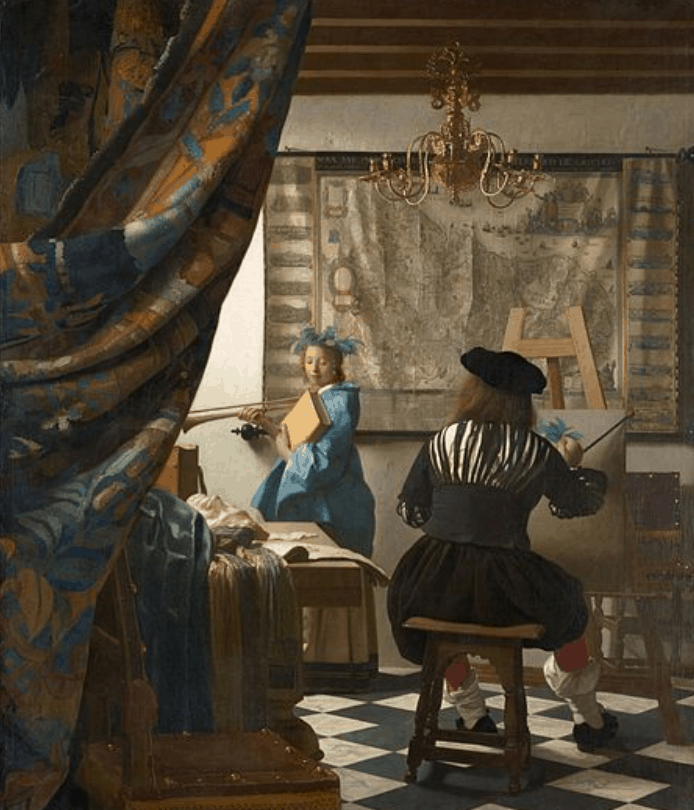
3. The Milkmaid
- Date created: 1657–1658
- Location: Rijksmuseum, Amsterdam, the Netherlands
The Milkmaid is also referred to as “The Kitchen Maid” and depicts a young woman as she is doing domestic work, a popular theme of Vermeer in many of his works. In this case, the woman is pouring milk into an earthenware container on a table, hence the name of the painting.
The painting hasn’t been dated so the date it was created is an estimate. It’s a rather small painting with dimensions of 45.5 x 41 centimeters (17.91 × 16.14 inches). It’s one of the most famous pieces of art in the Rijksmuseum’s collection.

4. View of Delft
- Date created: 1660–1661
- Location: Mauritshuis, The Hague, The Netherlands
View of Delft depicts Johannes Vermeer’s hometown of Delft, a town in the southwest of The Netherlands in between the metropolitan areas of Rotterdam and The Hague. It’s one of only 3 paintings of his hometown he ever created and only 1 of 2 that survived.
Because it’s rather unique in Vermeer’s collection and painted in a time when cityscapes were uncommon, it’s one of his most popular paintings. It has dimensions of 96.5 × 115.7 centimeters (38.0 × 45.6 inches) and has been in the possession of the Mauritshuis since 1822.
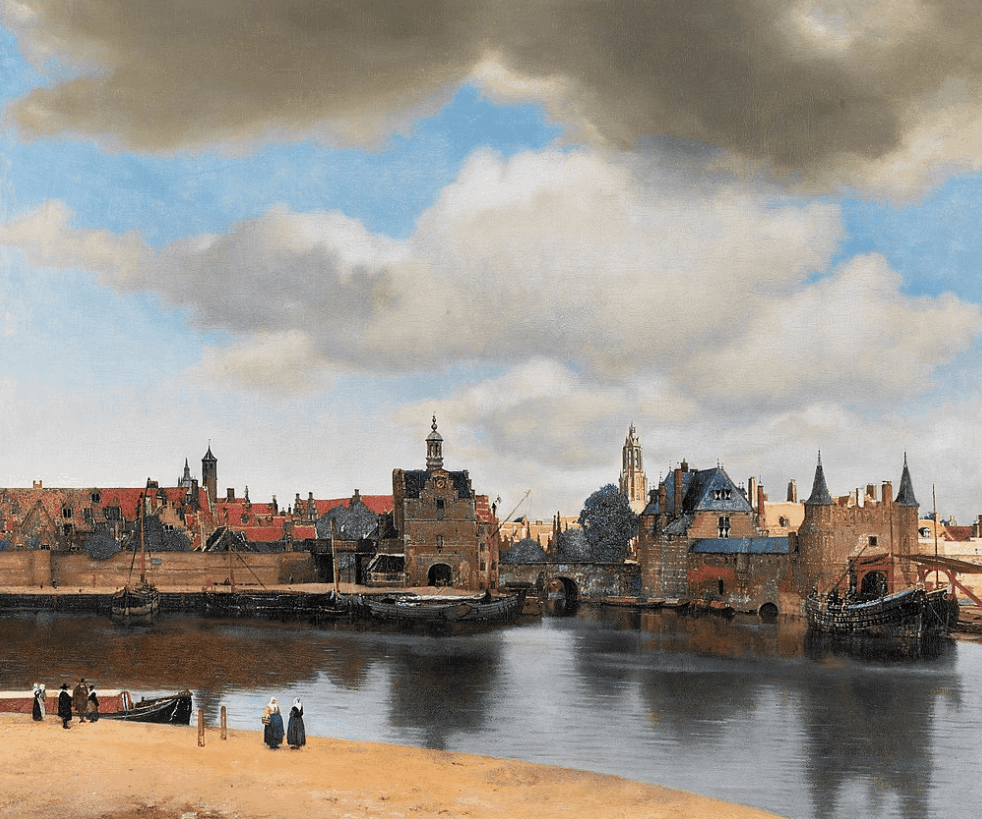
5. Woman with a Water Jug
- Date created: 1660–1662
- Location: Metropolitan Museum of Art, New York, United States
Woman With a Water Jug is also known as “Young Woman with a Water Pitcher” and is another Vermeer painting depicting a domestic scene. This painting is famous because it’s the first of his paintings that was brought to the United States.
The woman in the painting is holding a water jug in her left hand and is wearing a dark blue dress. A map is decorating the wall behind her. The painting has dimensions of 45.7 × 40.6 centimeters (18.0 × 16.0 inches).
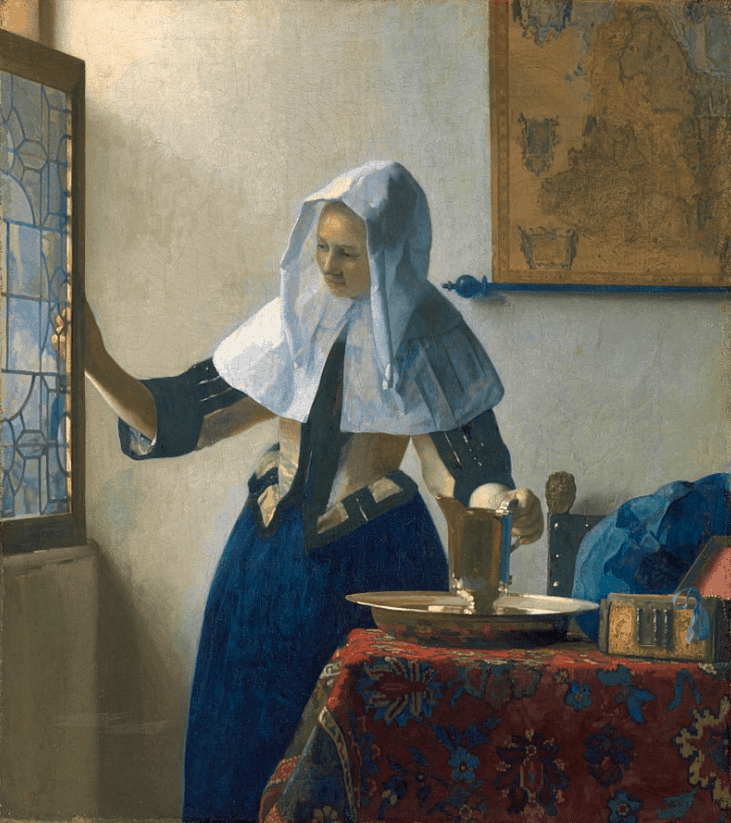
6. The Astronomer
- Date created: 1668
- Location: Musée du Louvre, Paris, France
The Astronomer is a painting depicting a man studying a celestial globe. This painting is believed to be closely related to his later work called “The Geographer,” a very similar painting believed to depict the same man.
The man in question is assumed to be Antonie van Leeuwenhoek, a famous scientist in the Dutch Golden Age referred to as “The Father of Microbiology.” The painting has dimensions of 51 × 45 centimeters (20 × 18 inches) and has been in the collection of the Louvre since 1983.

7. The Lacemaker
- Date created: 1669–1670
- Location: Musée du Louvre, Paris, France
The Lacemaker depicts a young woman as she is holding up a pair of bobbins in her left hand and carefully places a pin in the pillow to make lace. The woman is seated against a blank wall as well, which means Vermeer wanted to avoid any attention on anything else.
The painting has dimensions of 24.5 × 21 centimeters (9.6 × 8.3 inches) which makes it the smallest painting in Vermeer’s entire collection. It is currently on display at the Louvre in Paris.
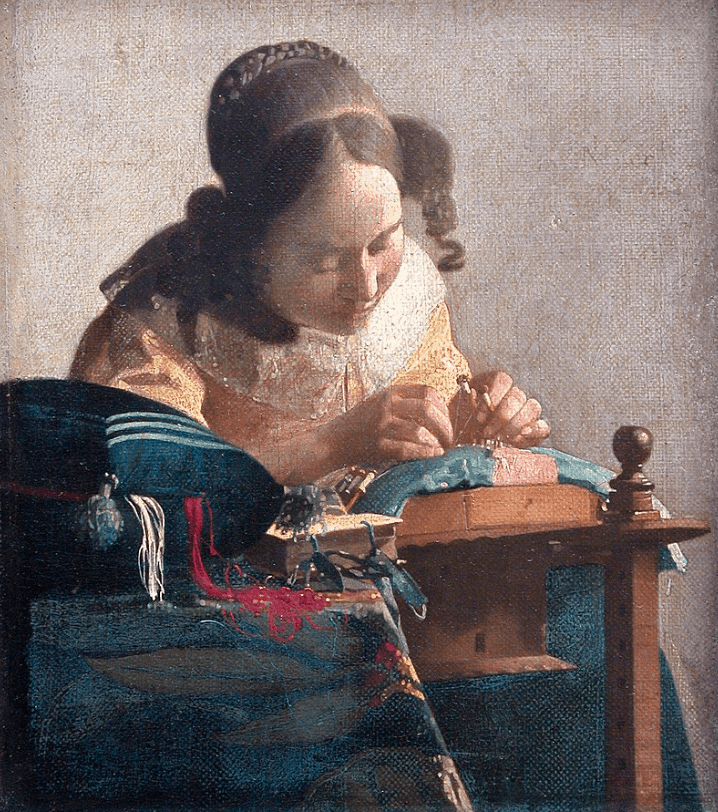
8. The Concert
- Date created: 1664
- Location: Unkown
The Concert is a painting that is believed to have been painted halfway through the 1660s and depicts a man and two women playing music. It was only documented for the first time in 1780.
The painting has dimensions of 72.5 × 64.7 centimeters (28.5 × 25.5 inches) and was on display at the Isabella Stewart Gardner Museum in Boston until 1990. It was stolen that year and up until now, it hasn’t been retrieved.
Experts value the painting at USD 250 million which makes it the most valuable stolen object in the world. If it hadn’t been stolen, it would have been the 14th most valuable painting in a museum today.
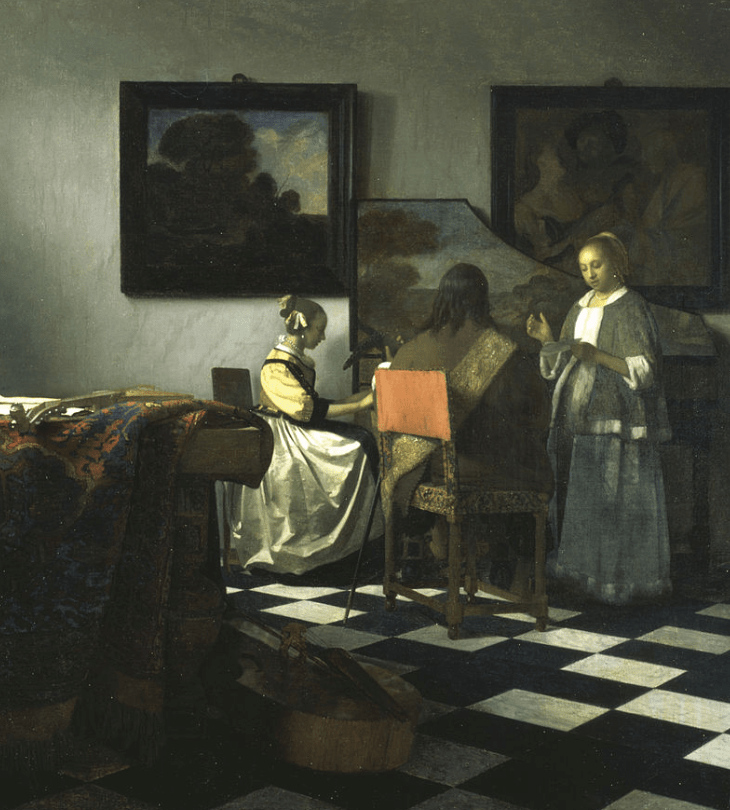
9. The Allegory of Faith
- Date created: 1670-1672
- Location: Metropolitan Museum of Art, New York City, United States
The Allegory of Faith can be described as a similar painting to the “Art of Painting,” in which the painter portrays an allegory of the main topic. In this painting, the woman is sitting in front of a large painting of Christ’s crucifixion.
The painting has dimensions of 114.3 × 88.9 centimeters (45.0 × 35.0 inches), making it one of his larger works. It also differs from his usual style and theme, even though the woman is depicted in a domestic setting.

10. Woman Holding a Balance
- Date created: 1662–1663
- Location: National Gallery of Art, Washington, D.C., United States
Woman Holding a Balance was originally called “Woman Weighing Gold” until it was discovered that the balance the woman is holding was empty. Therefore, it was originally renamed “Woman Testing a Balance.”
It’s one of the most fascinating paintings by Johannes Vermeer because the main theme of the work isn’t exactly clear. The woman appears to be pregnant, she holds an empty balance, and the wall behind her is decorated with a painting of the Last Judgement depicting Christ with raised, outstretched hands.
The painting has dimensions of 42.5 × 38 centimeters (16.7 × 15 inches) and has been described as a work meant to serve as a meditative aid to leading a thoughtful and balanced life.
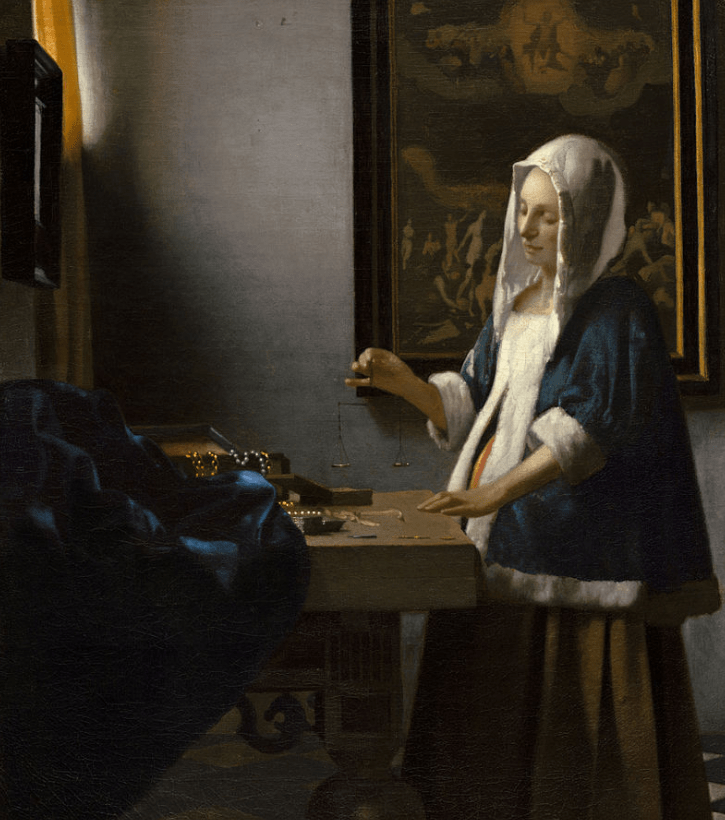
11. Christ in the House of Martha and Mary
- Date created: 1655
- Location: Scottish National Gallery, Edinburgh, Scotland
Christ in the House of Martha and Mary is one of the earliest paintings created by Johannes Vermeer and is the largest in his oeuvre as well. It has dimensions of 160 × 142 centimeters (63 × 56 inches) which is significantly larger than any painting he produced after it.
It’s also the only painting that depicts an overtly religious story, namely a story from the Gospel of St Luke in which Christ visits the house of Mary’s sister Martha. Regardless of this notion, he did integrate multiple religious symbols in his work and his Allegory of Faith is also predominantly religious.
It’s on display at the Scottish National Gallery and has been since 1926, only a couple of decades following the discovery of the signature of the artist in the early 20th century.
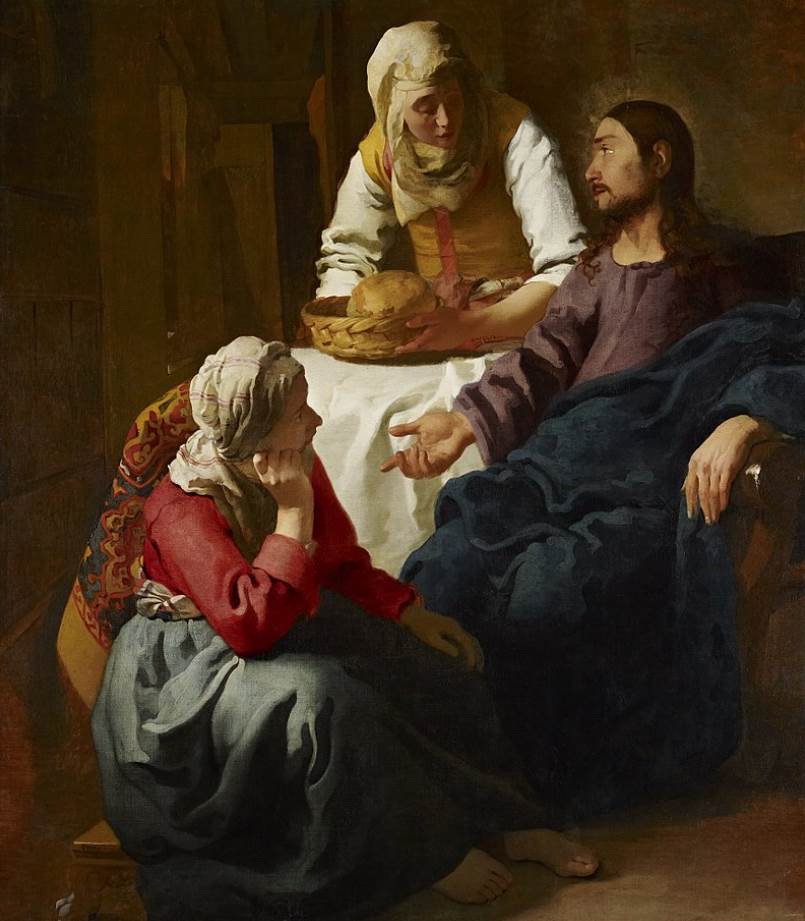
12. The Little Street
- Date created: 1657-1658
- Dimensions: 54.3 × 44 centimeters (21.4 × 17 inches)
The Little Street is the other one of the two surviving paintings by Vermeer that depict a scene in his hometown of Delft. We can see a couple of ordinary houses in a small street and a background filled with a sky and clouds.
The exact location of this painting was the subject of extensive debate for multiple decades. The mystery was finally solved when a tax register from 1667 provided the definitive answer with the location being determined as an obscure street in the eastern part of the city.
The house on the righthand side was owned by the artist’s aunt and the little gate was referred to as the “Penspoort,” a reference to the tripe you could buy there. The artist’s mother and sister also lived on this street, another reason why he chose to depict this location.

13. Girl Reading a Letter at an Open Window
- Date created: 1657-1659
- Dimensions: 83 × 64.5 centimeters (33 × 25.4 inches)
- Location: Gemäldegalerie in Dresden
Girl Reading a Letter at an Open Window is another typical painting by Johannes Vermeer in which his mastery of using light shines. We can see a girl reading a love letter near an open window in a room inside Vermeer’s house in Delft.
The delicate intimacy is emphasized by the fact that the viewer is watching the scene from behind a rug-covered table and drapery. This remarkable skill creates some distance between us and the girl as she fully emerged in reading her letter.
Part of the painting was overpainted by an unknown painter at a later date but this has been restored in 2021. This restoration revealed a painting that hangs on the wall of the room depicting Cupid, something that confirms the theory that the girl is reading a love letter.
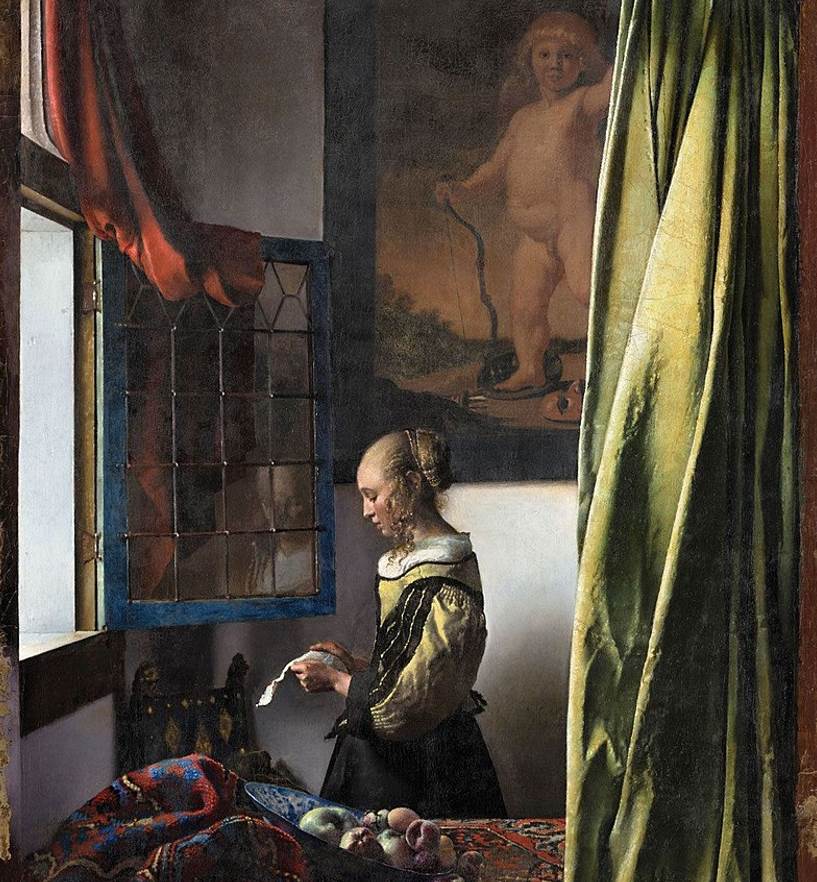
14. The Procuress
- Date created: 1656
- Dimensions: 143 × 130 centimeters (56 × 51 inches)
- Location: Gemäldegalerie in Dresden
The Procuress is a painting by Johannes Vermeer that was completed when he was only 24 years old. We know this for sure because it’s one of the 3 paintings in his remarkable oeuvre that has been signed and dated.
It’s one of the most fascinating paintings by Johannes Vermeer because it includes what is believed to be the only self-portrait of the artist. Art historians believe that the young man on the left is the painter himself.
It’s also the second-largest painting he ever produced after Christ in the House of Martha and Mary and is quite atypical because it doesn’t feature the same light effects as most of the other works that he painted inside his house.

15. The Music Lesson
- Date created: 1662-1665
- Dimensions: 74.6 × 64.1 centimeters (29.4 × 25.2 inches)
- Location: Queen’s Gallery, London, United Kingdom
The Music Lesson is a Vermeer painting that is also sometimes referred to as “Woman Seated at a Virginal” or “A Lady at the Virginals with a Gentleman.” It depicts a woman playing music at a virginal and a man who appears to be singing next to her.
There’s an inscription on the virginal, a type of keyboard instrument that was popular during the Baroque era, which might be a reference to the romantic relationship between the man and woman. There aren’t any more clues so we have to guess what it is.
The painting was part of the artist’s collection when he passed away and eventually made its way from Venice to England. It’s part of the Royal Collection and is on display at the Queen’s Gallery, the main public art gallery of Buckingham Palace in London.

16. Officer and Laughing Girl
- Date created: 1655-1660
- Dimensions: 50.48 cm × 46.04 centimeters (19.87 × 18.13 inches)
- Location: Frick Collection, New York City, United States
Officer and Laughing Girl is a painting by Vermeer that follows the same pattern as many other of his works. The main light source comes from the left and it appears to depict a scene that takes place in the same room as many of his other works.
The map on the wall in the background is Blaeu’s 1621 map of Holland and West Friesland and accurately depicts the geographical features. This mao was featured several times by the artist.
Vermeer used the so-called “repoussoir” technique in this work. The officer wearing an expensive hat in the foreground directs the viewer toward the smiling girl at the table. His wife possibly served as the model for this girl, although this suggestion can’t be confirmed.
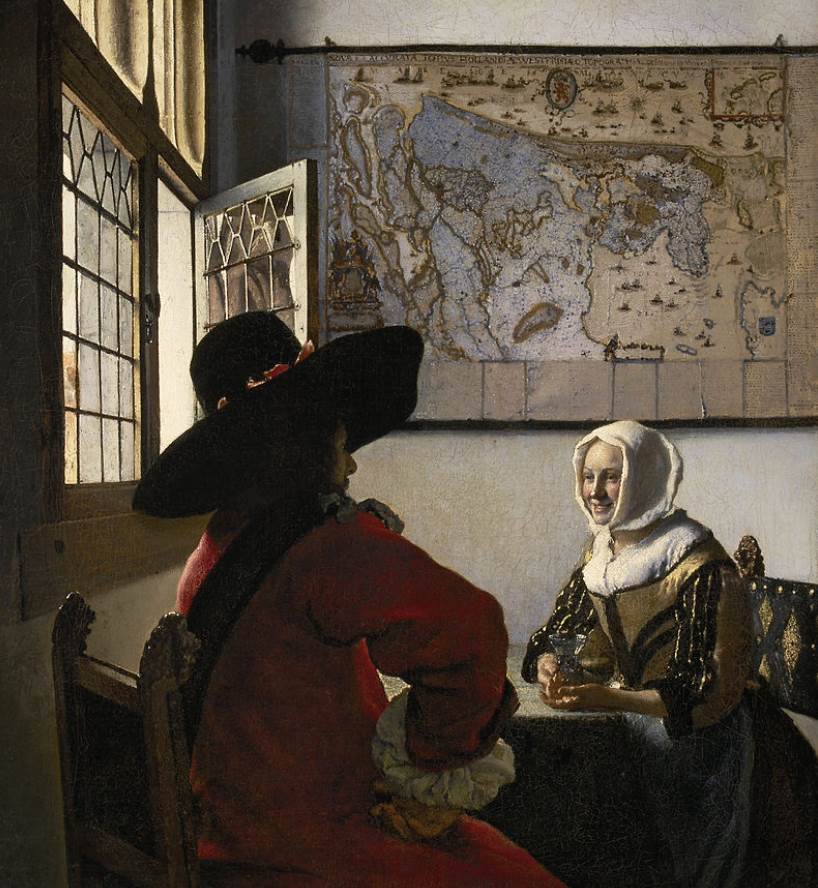
17. Girl Interrupted at Her Music
- Date created: 1658-1659
- Dimensions: 39.4 × 44.5 centimeters (15.5 × 17.5 inches)
- Location: Frick Collection, New York City, United States
Girl Interrupted at Her Music is a painting that Vermeer completed shortly after Office and Laughing Girl. He integrated a new technique to depict an interruption which was to make the girl stare at the viewer. This means she looks rather serious instead of making an artificial expression.
It depicts a scene in the same room, a notion that we can see by the paneled window that is the only source of light. Some other items are also featured in other Vermeer paintings such as the Delft porcelain vase, the glass of wine, and the Cupid painting on the back wall.
This painting probably depicts a scene related to love. the untouched glass of wine might hint at a starting relationship and music was generally associated with love in the 17th century. Unfortunately, this small painting is in relatively bad condition.
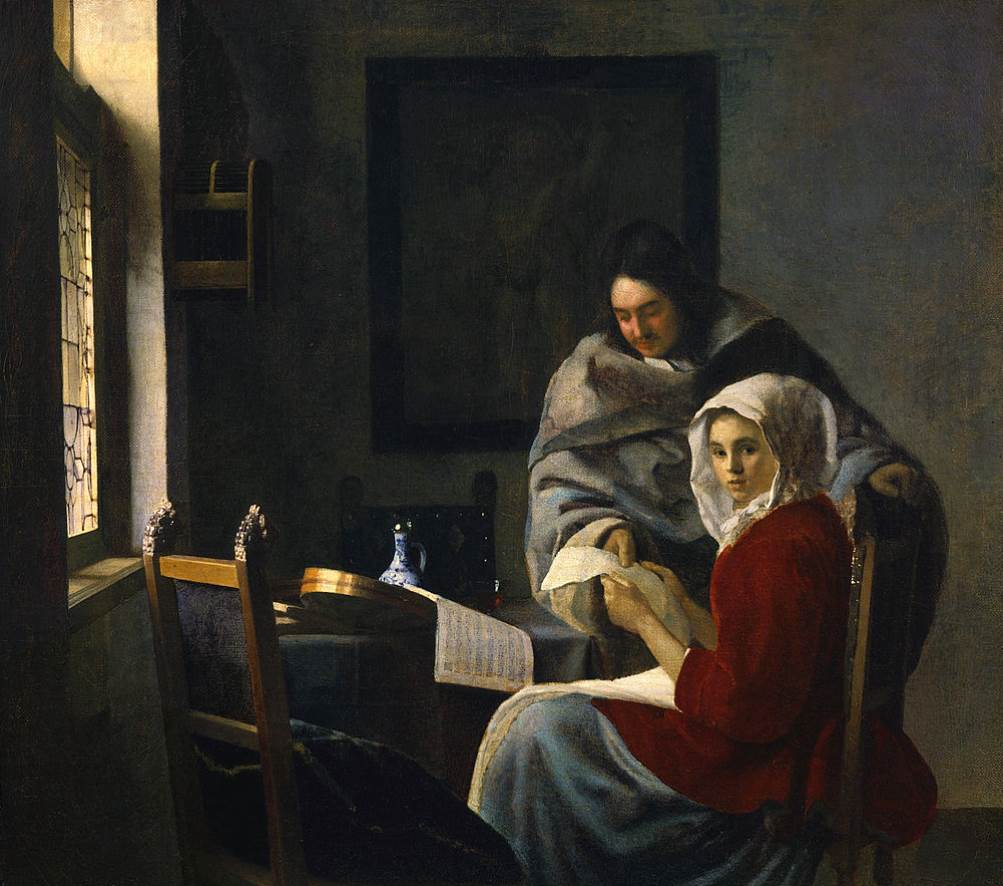
18. The Wine Glass
- Date created: 1658-1660
- Dimensions: 67.7 x 79.6 centimeters (26.6 x 31.3 inches)
- Location: Gemäldegalerie, Berlin, Germany
The Wine Glass was a painting that was probably completed when Vermeer was in his late twenties, although the work isn’t dated. It’s considered to be one of the first mature works by the artist who started developing the meticulous level of detail of the common objects that can be found in the room.
This work depicts two people, a man who is grabbing a wine pitcher, and a woman who is just finishing a glass of wine. The exact relationship between both remains unknown and it’s clear that Vermeer didn’t master social fluidity between the main figures just yet.
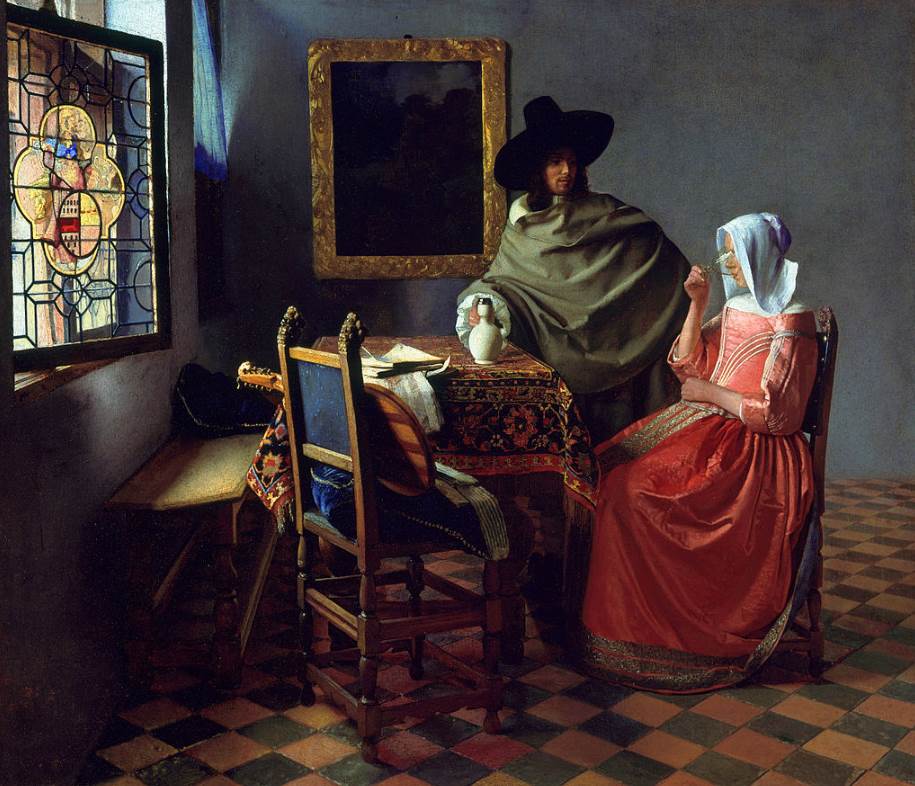
19. The Geographer
- Date created: 1668-1669
- Dimensions: 52 × 45.5 centimeters (20 × 17.9 inches)
- Location: Städel Museum, Frankfurt, Germany
The Geographer is another small painting by Vermeer that presumably depicts the same man as in The Astronomer. The man is studying maps and charts and is holding a divider, a typical tool used by a man in this profession.
Both paintings were believed to be pendants until the late 18th century, the time that they were separated. The composition of this work is very similar to many other of his other paintings, including the light source that comes from the left and the items in the room.
It’s another painting that highlights Vermeer’s mastery of light and shadow as he magnificently captured every detail on the items, the man in the center of the composition, and the wall in the background. This wall also features Vermeer’s signature and the date.



